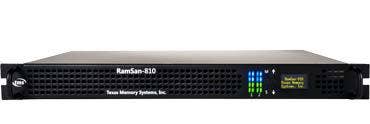Texas Memory Systems Intros eMLC-based Flash Storage Appliances

The RamSan-810 packs up to 10 TBs of high-performance Flash storage in a 1U enclosure, and features an 8-Gbit Fibre Channel or an InfiniBand interface, said Erik Eyberg, senior analyst for the Houston-based vendor.
A single rack with 40 RamSan-810 appliances would provide 400 TBs of capacity with throughput of 160 GBs per second and performance of 12.8 million IOPS, but use only 10kWh of power, TMS said.
The RamSan-810 is built using eMLC Flash technology from Toshiba. eMLC, or enterprise multi-level cell Flash, fits in between single-level cell (SLC) and MLC Flash technologies. SLC technology allows 100,000 program erase cycles at the raw chip level compared to only 3,000 to 5,000 program erase cycles for MLC. However, eMLC boosts that to about 30,000 program erase cycles at about half the price of SLC Flash, Eyberg said.
"It's intended as primary storage," Eyberg said. "Although in some cases where a customer has hundreds of TBs of data, it can be used as a cache. But its main position is for use in application acceleration."
The reliability of data on the RamSan-810 comes from TMS's Flash controller which includes the company's patented Variable Stripe RAID (VSR) algorithm, which automatically bypasses failing chips, Eyberg said. It is rated for a 10-year life with a 50-TB-per-day write workload, he said.
Jamon Bowen, director of sales engineering for TMS, said the reliable application acceleration provided by SSDs is important to the channel because it gives solution providers the opportunity to talk to customers about their applications.
"Instead of focusing on the number of servers a customer deploys, talk about their applications," Bowen said. "Get to the core of your customer's business. And since the RamSan-810 is half the cost of comparable SLC Flash storage, partners can get SSD into customers' tier-one storage at the same price as large vendors' disk storage."
Over 70 percent of TMS's sales go through indirect channels, Bowen said.